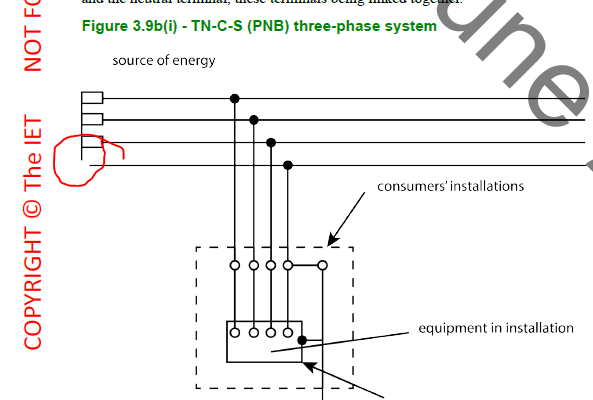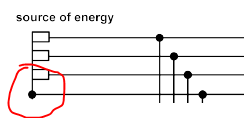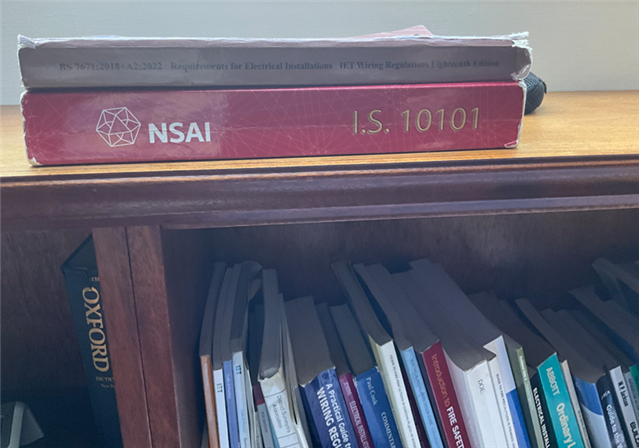I am hearing from my network that the DPC for AMD 4 went on line this morning and is available on the BSI website.
JP fires starting gun for a very long thread?
JP
I am hearing from my network that the DPC for AMD 4 went on line this morning and is available on the BSI website.
JP fires starting gun for a very long thread?
JP
Based on recent conversations my guesstimate will be only single figure percents, maybe less than that - which is a shame as there is a disconnection risk between the way things are intended to work in standards world, and what happens in the one outside, and it is useful, in both directions, for there to be a flow of information - both to explain why rules are being revised or considered, and at the same time to report back what problems and failure modes are happening and causing problems in actual practice.
Canvassing opinions over a beer or two, yields what to me seem some really odd topics - Are there more nuisance RCD trips than real ones for example -it seems so when induction hobs are installed ;-) Are folk still putting in split load units, yes apparently. Does everyone understand how to measure the resistance of an earth rod indeed or when we need one, apparently not all that well...
For those who don't know I've just spent a couple of weeks being far more hands-on than is normal for me these days with the electrics of the Essex Jamboree- think 10000 Scouts and leaders in a field, lots of gensets lots of wire and a rather hassled team of us keeping the lights on and diesel flowing. But I like to take the chance to chat and see what folk are doing who work in other areas.
M.
Actually, at least on site where more than one LV TX is in parallel you may see multiple NE links, and it tends to be inside with the TX outside, and then arguably it is part of the consumer side stuff, just upstream of any loads - and I do mean the UK. Note also that the domains of the ECSQR and BS7671 don't overlap - i.e. there are areas of the planet that use BS7671 (Qatar, Malta, probably others ? ) that have no such NE combination prohibition.
But the diagram thing is interesting. I agree that PNB especially is not always clear to folk, even if I think its clear to me.
Perhaps on a related note we should ask DNOs to write in Sharpie on the meter boards what they think the earth arrangement is supposed to be - as they used to have to do when PME first came out
. 
I'm not sure if the standard drawings are inherited from another standard.
Mike.
As per your diagram, isn't the N conductor actually a PEN conductor? My understanding is that the conductor is only N when the LV neutral and LV earth have been separated.
Also, I noticed the PNB diagrams in BS 7671 Amendment 4 don't show a connection between the neutral of the transformer and the PEN. Is this correct?
There has been some suggestion that more of us should comment on these DPCs, and I think it was mapj that suggested only a single percentage of us (is that somewhere between 0%-9%) might be doing so?
I can only speak for myself, and perhaps profusely apologise to Graham et al........some of whom know me, but I assume that a panel of experts, who worry - right overboard worry - and stress and cant sleep at night due to this worry - about health and safety, and electrical safety, sit down and stress and worry about all the different ways that we might get a shock, or potentially die. And draw up new regulations to try and cover all these different scenarios, write a regulation to cover it, find out about the law of unintended consequences and re-write the regulation again to minimise the unintended consequence's. I assume a LOT of thought gets put inot these changes and updates, with many meetings between many concerned, well meaning men and women. I doubt I've any valued added benefit to it.
Clearly (to me) the 16th edition was a big change (step?) to electrical safety (IMO) but between then and now, other than RCDs being more of a thing, the regulations seem to have just expanded on what's already there. More special locations, more appendices etc - but essentially, it was all still in the 16th
Are these new regs so different to the 16th edition? That book is half the width of the 18th. Simpler.
I'd like to think that I had a big enough presence on the old forum, that I can show my knowledge of the regulations is probably quite good, (Not compared to some on here, obviously) but I - in no way - feel like my input on the DPCs might be valuable. Every point I bought up has probably have been debated already, and more than likely I'd sound dumb.
My attitude is something along the lines of, in grumpy voice, "Just tell me the regulations and I'll do my best to implement the dam thing."
I've long predicted the fragmentation of our industry and the regulations and we'll soon all be qualified only to work in certain sectors of the industry and we'll only need to know and understand regs applicable to that specific industry. In future, We'll be actively prevented from working in sectors of the industry - regardless of our experience - until we pass this course or that course. Paper proof of "Competency".
I do not support this at all (Bod's - I hope he's still around reading this but I guess he's not- and OMS oft repeated admonitions of - "be careful what you wish for" - spring to mind. But I see it as inevitable that the way we are moving - and already the regs books are too much for most electricians unless you're in charge of the job QS or company AP or similar. I can say there are large sections of the regulations I am aware of, and rarely use; I know that if a project comes up in that section I'd better check up my understanding.
As per your diagram, isn't the N conductor actually a PEN conductor? My understanding is that the conductor is only N when the LV neutral and LV earth have been separated.
Well spotted, but actually deliberate. My suggestion is that it provides no earthing function upstream of the earthing point since there are no exposed-conductive-parts upstream to connect it to (the transformer metalwork is conventionally connected to the HV earthing system where PNB is used, not the LV one and in the DNO world it's (AFAIK) always in rural areas with overhead lines (ABCs or open wire)- so not even any outers of concentric cables to worry about. So other than the 2nd case it's really TN-S rather than TN-C-S we're dealing with (but the DNOs will likely impose PME conditions anyway, to leave room for future reconfiguration)..
Also, I noticed the PNB diagrams in BS 7671 Amendment 4 don't show a connection between the neutral of the transformer and the PEN. Is this correct?
I thought not - hence they're connected on mine!
- Andy.
Well spotted, but actually deliberate. My suggestion is that it provides no earthing function upstream of the earthing point since there are no exposed-conductive-parts upstream to connect it to (the transformer metalwork is conventionally connected to the HV earthing system where PNB is used, not the LV one and in the DNO world it's (AFAIK) always in rural areas with overhead lines (ABCs or open wire)- so not even any outers of concentric cables to worry about. So other than the 2nd case it's really TN-S rather than TN-C-S we're dealing with (but the DNOs will likely impose PME conditions anyway, to leave room for future reconfiguration)..
Would the single point bonded AWAs not be considered an exposed-conductive part? These are upstream of the LV neutral and LV earth link.
EDIT: my understanding is that the neutral conductor, as per your drawing, will form part of the earth fault loop of most earths faults that can take place within the consumers' installation. Meaning the conductor is acting as a neutral and earthing conductor... i.e. a PEN conductor... Apologies if I'm barking up the wrong tree!
I thought not - hence they're connected on mine!
I agree, I think they need to be shown as connected. Happy to be proven wrong, though.
i.e. yo mean is this a mistake ?
Agree also. Should look more like this (though I have fudged this by care fully cropping the TN-S one. So ignore the dot.. )
Note that this simplification is OK for a genset, a real transformer will have some kind of HV earth connected to the metal of the core and the tank somehow to operate an HV trip if the primary insulation fails.
M.
Would the single point bonded AWAs not be considered an exposed-conductive part? These are upstream of the LV neutral and LV earth link.
Ah, for private transformers - yes that might be a possibility. I was thinking more of the usual DNO layout which tends not do that sort of thing. Maybe that's even more reason to treat the private/public situations distinctly.
EDIT: my understanding is that the neutral conductor, as per your drawing, will form part of the earth fault loop of most earths faults that can take place within the consumers' installation? Meaning the conductor is acting as a neutral and earthing conductor... i.e. a PEN conductor? Apologies if I'm barking up the wrong tree!
No apologies needed - it's good to debate these things. My counter argument is that it would be the same for the (short) connection between the N-PE link and the star point on a conventional TN-S system - but we don't tend to refer to those as PEN conductors nor say it's really a TN-C-S system. Indeed some care is needed - since it's unlawful in the UK for a consumer to have a combined earth & neutral conductor within their installation, we don't want a situation any attempt to create a local TN system will fall foul of the law.
- Andy.
Would the single point bonded AWAs not be considered an exposed-conductive part? These are upstream of the LV neutral and LV earth link.
Thinking again... wouldn't these be connected to the earth bar, at or downstream of the electrode connection, rather than to the "N"/"PEN" conductor upstream?
- Andy.
Well made points Tatty! I was taking a 2391 course for a number of contractors and their operatives from the ROI. Out of interest, I asked the lads about how much they used IS10101. "Too fat!" was the cohort consensus. "Nobody uses it, we just do it the way we always have." By "nobody" they mean the practitioners at the coalface. Required changes, they say, are mostly met by word of mouth, trade press, wholesalers or when the Safe Electric inspector admonishes them etc.
However, whilst the standard is an obligatory part of the approved contractor library, nothing persuades them to turn its pages.
Since the issue of IS10101 2020 (the Irish Regs), I have been trying to map the differences between it and BS7671. Although a corrigendum has been issued to the former, no amendments to date.
I would agree that both documents are putting on too much weight and both are increasingly technically complex. There is no appetite for the ordinary spark to engage with the documents on any kind of substantial basis other than when the doyens of the industry require them to be herded into a tightly squeezed training course where bucket loads of information is dumped on them only to be instantly forgotten after the first pint, all in an effort to keep them up to date and, dare I say it, keep them competent.
Whilst it is to be admired that the IET provide the consultation process and genuinely seek feedback from those at the coalface, my experience of almost 30 years as a part-time tutor would indicate that their task will be a mammoth one.

We're about to take you to the IET registration website. Don't worry though, you'll be sent straight back to the community after completing the registration.
Continue to the IET registration site